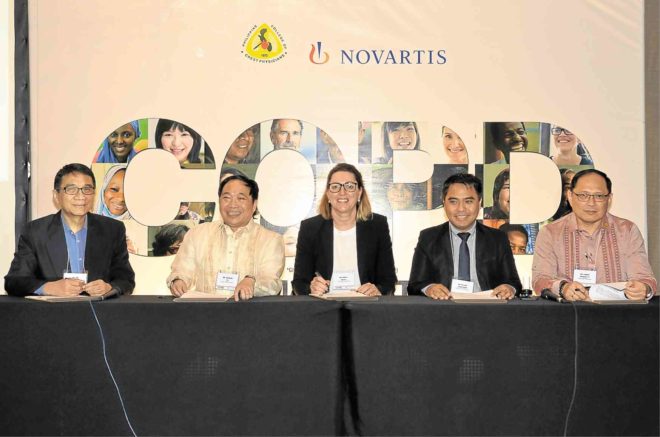
Imagine breathing through a straw. Now try walking around while breathing through a straw. That’s what it’s like to live with chronic obstructive pulmonary disease (COPD)—it cripples you physically, emotionally and psychologically, ultimately shutting down your social contact as breathing becomes an exhausting exercise.
It’s a long and arduous journey for COPD patients, and it’s one that always ends in a painful death, akin to slowly drowning, Dr. Tim Trinidad, chair of Council on COPD and Pulmonary Rehabilitation, told Lifestyle during the launch of Breathe (Broadening Reach, Enhancing Awareness, and Transforming Health Education).
Breathe, a campaign by the Philippine College of Chest Physicians (PCCP) and Novartis Healthcare Phils., aims to increase public awareness of how to avoid or mitigate COPD risk factors and to enhance the knowledge of local healthcare professionals about COPD diagnosis and management.
Smoking ban
“We laud the government’s intensified antismoking campaign, which will help prevent many tobacco-related diseases and conditions among Filipinos,” said Cheryl Maley, president and managing director of Novartis Healthcare Phils. “However, COPD remains in the top 10 of the 48 diseases and conditions—both noncommunicable diseases (NCDs) and infectious ones—
that collectively account for 80 percent of the Philippines’ overall disease burden.”
Seventh
Now the seventh leading cause of death in the Philippines, COPD is projected to become the third leading cause of death in the world by 2020, next to heart disease and stroke.
COPD is silent in the early stages, with symptoms manifesting only until 20-50 percent of the lungs have already been damaged. Usually, 50 percent of lung function has already been lost at the time of diagnosis.
A quarter to one-half of the people with COPD do not know they have it, especially in the early stages, dismissing symptoms such as shortness of breath, wheezing, chronic cough and bringing up phlegm as a normal part of aging or an expected consequence of cigarette smoking, Trinidad said.
So what exactly is COPD, and who gets it?
COPD is often a combination of two conditions—emphysema and chronic bronchitis. It starts when harmful gases are inhaled and damage the lungs’ airways and air sacs.
Airways are tubes that carry air in and out of the lungs. Healthy airways and air sacs are elastic, bouncing back to their original shape after being stretched or filled with air. It is this elastic quality that helps to move the air quickly in and out. In people with COPD, the air sacs no longer bounce back to their original shape, and the airways have become swollen, blocked or obstructed, making it harder to get the air out of the lungs.
Secondhand smoke
Smokers, people exposed to secondhand smoke, air pollution, biomass fumes (burning charcoal or firewood for cooking, such as during barbecues, in poorly ventilated homes), occupational dust, and people who have had childhood respiratory illnesses like pneumonia are at risk of developing COPD.
Trinidad said people who have been smoking a pack of cigarettes for the past 10 years, or 1/2 pack for the past 20 years, are at higher risk of developing COPD.
“For past smokers, inflammation of the lungs is usually continuous even if you stop. But if you stop, it will lessen the inflammation, and progression of the disease will slow down,” Trinidad said.
COPD also increases your risk of developing heart disease, lung cancer and other conditions. It is treatable, but not curable. With proper treatment, people with COPD can control their symptoms and enhance their quality of life.
“We used to believe that the lung function deteriorates at the late stage of the disease, but now we know it begins to deteriorate drastically during the mild and moderate stage of the disease before it tapers off,” Trinidad said.
This discovery makes it even more critical to get diagnosed early on in the disease.
“Your smoker’s cough might be COPD, that episodic upper respiratory tract infection that you thought might be viral could be COPD,” Trinidad said.
Get yourself tested, he said. The gold standard is the painless test called spirometry (lung function testing).
Another problem, Trinidad said, apart from lack of public awareness about the disease, is the lack of awareness among healthcare providers. They don’t have a high index of suspicion looking out for COPD patients, he said.
With the Breathe initiative, continuing medical education activities will also be conducted to enhance the knowledge of local healthcare professionals in COPD diagnosis and management, specifically in spirometry. It will also include the provision of medical services such as spirometry.